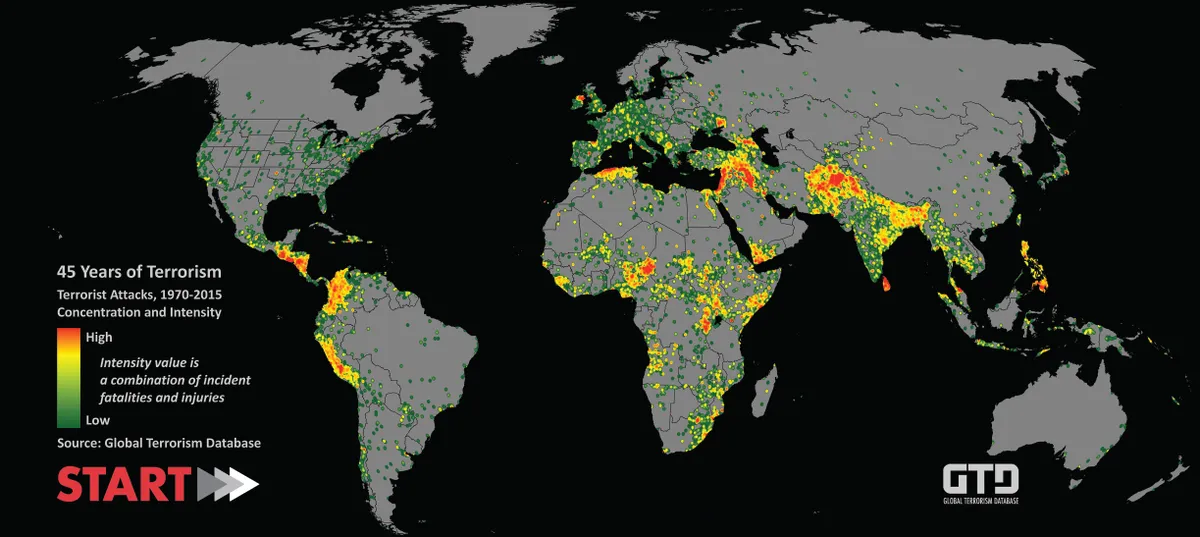Are there patterns in terrorist attacks that could help us predict or even prevent them? It’s a question that first occurred to Prof Neil Johnson, a physicist at the University of Miami while he was visiting Colombia in the 1990s.
Since the mid-1960s, the country has been in the grip of a conflict between the government and various insurgent groups. “I’d turn on the news and see that three people were killed today, then no one the next, then five, then two, then six,” says Johnson. “It’s a complicated set of numbers and I thought, let’s look at them.” His efforts to find a signal in that noisy data proved fruitful.
Later, when he and economist Prof Mike Spagat at Royal Holloway, University of London, analysed a database of 20,000 attacks in Columbia and plotted them against the number of people killed in each one, they ended up with a distinctly shaped graph. It started high near the Y axis, but dropped steeply before levelling off and running almost parallel with the X axis.
Read more 2019 science breakthroughs:
The graph’s high peak reflected the small number of attacks that had high death tolls, while its long tail was indicative of the large number of attacks with smaller numbers of casualties. Interestingly when they did the same with data on attacks that followed the 2003 invasion of Iraq, it showed exactly the same pattern. What they’d discovered was a mathematical relationship called a ‘power law’, something that computer scientist Asst Prof Aaron Clauset at the University of Colorado at Boulder stumbled upon at a similar time.
The discovery of the power law relationship between the number of attacks and the number of people killed allows forecasts to be made. “It allows us to extrapolate in a mathematically principled manner, to make statements about events that are incredibly rare,” explains Clauset.
The chance of another terrorist attack on the scale of 9/11, which killed 2,996 people, is 30 per cent over the next 10 years
This kind of extrapolation led to Clauset’s forecast that the chance of another terrorist attack on the scale of 9/11, which killed 2,996 people, is 30 per cent over the next 10 years. The maths can build expectations about the frequency of large-scale terror events, says Clauset. “But it doesn’t allow us to predict when, why or how the next event will happen.”
Some researchers, though, are using maths to try and predict who will be behind the next attack. When they compared the number of insurgent groups in places like Iraq and Colombia with the sizes of those groups, something familiar pops out: the power law. In other words, the distribution of the sizes of the groups is almost identical to the distribution in the scale of attacks, with lots of small ones and a handful of very large ones. After all, it’s logical that the handful of large groups it predicts will be able to carry out far more destructive attacks than the vast number of small groups or ‘clusters’ of fighters.
“By cluster, we don’t mean that the members walk around in a bunch, like kids in a playground,” says Johnson, “but that they are coordinated in some way, such as by some means of modern communication. So it can apply to a cluster of people in the desert during the Iraq era, but it also applies to more tech-savvy groups of terrorists located in different places.”
Key Data
Although it’s impossible to know the size of a cluster carrying out attacks, the researchers can get data on the online individuals who support a cause or ideology. In fact, the data is freely available, as most groups are visible online to encourage new recruits.
Johnson and his colleagues studied pro-ISIS groups that share information, such as advice on financing terror attacks or how to avoid drones. Facebook aims to shut extremist groups down quickly, but pro-ISIS groups seem to be more prevalent on other online platforms. In a study of open-access information on VKontakte, based in Russia, Johnson found 196 pro-ISIS groups with over 100,000 followers. Groups were shut down within weeks, but the members would simply form a new one or join another existing one. It’s these groups that followed the power law in their scale. And this fluid online world of ISIS support, where groups coalesce, disappear and reform, suggests a means to thwart them: split them up before they have time to form larger, more deadly groups.
Doing so won’t eradicate terrorist attacks – it’s likely nothing ever will. But it could limit the impact their attacks have. Hopefully 2019 will be a better year.
45 years of terrorism
Heat map showing all known terror attacks between 1970 and 2015

Listen to an episode of Discovery – Can maths combat terrorism? bbc.in/2COwdWa

Follow Science Focus onTwitter,Facebook, Instagramand Flipboard
